What is Canine Distemper (CD)?
Canine Distemper (CD) is a deadly viral infection in dogs caused by the Canine Distemper Virus (CDV), now known as Canine morbillivirus. It is a highly contagious disease that attacks multiple organs and organ systems of the infected dog.
Canine distemper virus can affect multiple species of animals including foxes, wolves and even lions. However, dogs are most at-risk of developing the disease. Cats can become infected, but they do not show any signs of distemper infection.
What Causes Canine Distemper?
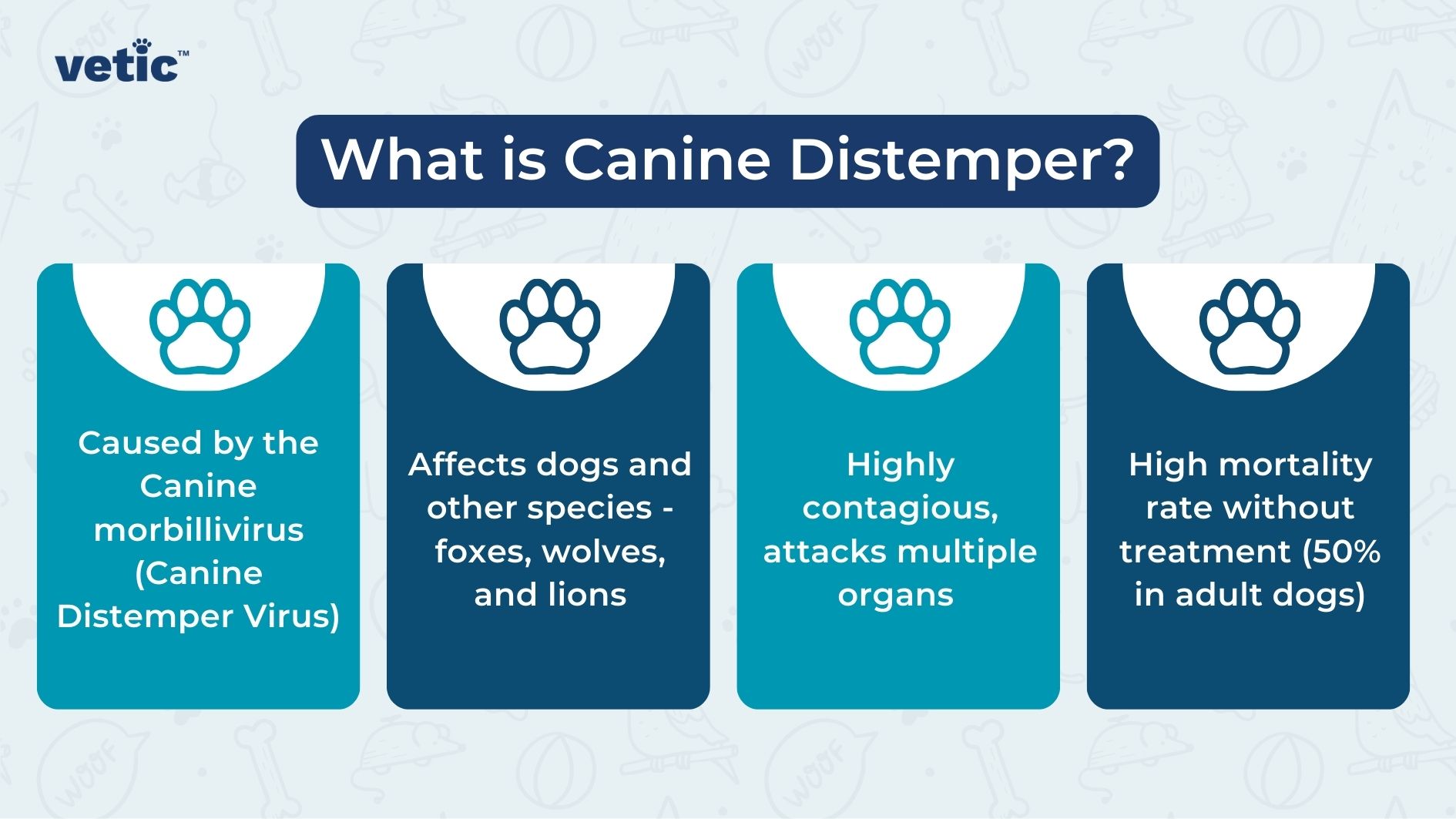
Canine distemper is caused by a RNA virus called Canine morbillivirus (member of Mononegavirales). It is a unique virus that can affect multiple cell types at the same time in the same individual.
That makes canine distemper a systemic viral disease in dogs with a high mortality rate.
How Does Canine Distemper Spread Among Dogs?
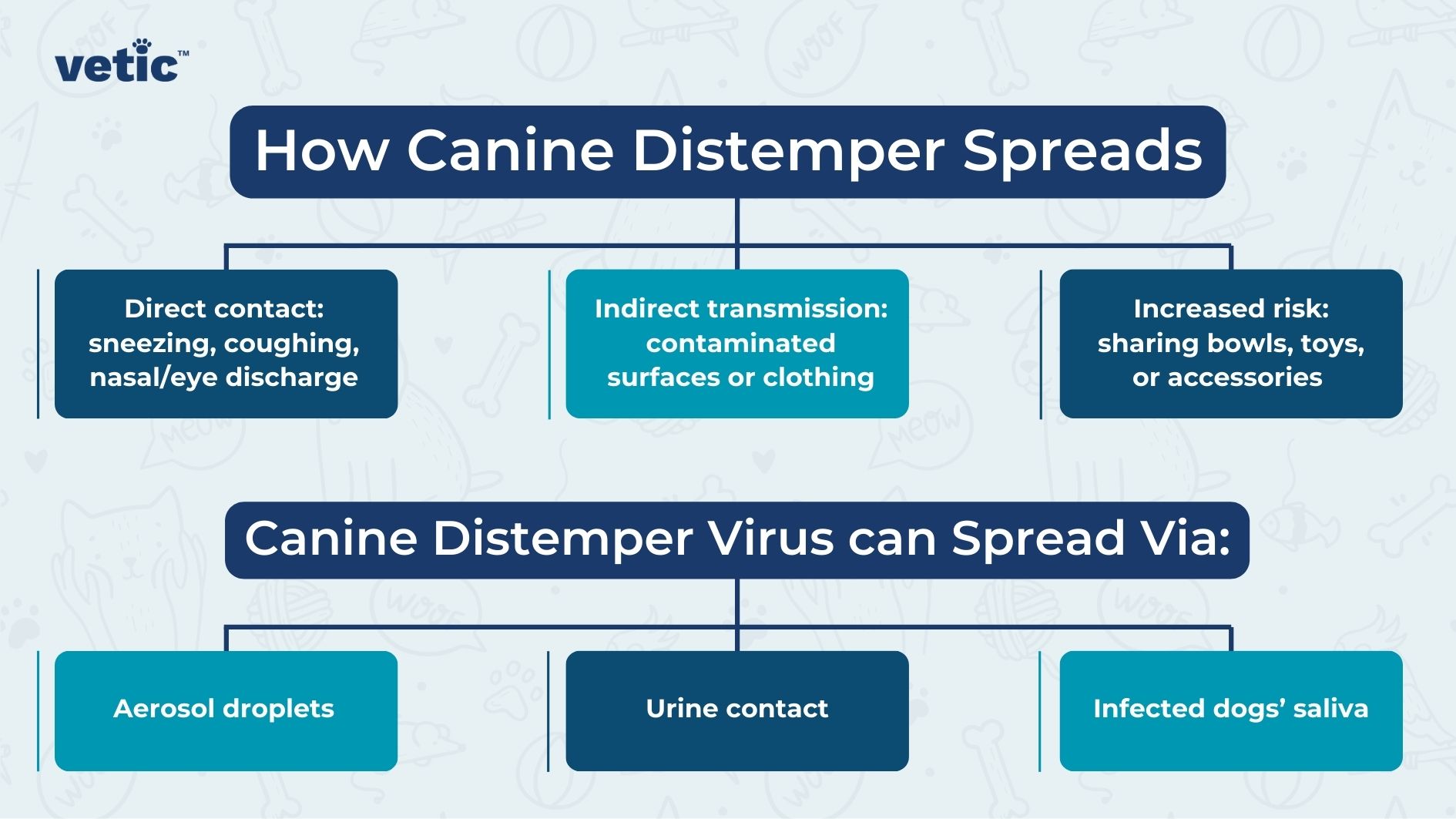
Canine distemper spreads a lot like common cold spreads among humans – via aerosol droplet secretions from the infected dog. Indirect transmission of canine distemper is also possible, for example – If we come into contact with eye or nasal discharge of an infected dog, and then come into contact with another dog who inhales (sniffs) or licks the contaminated clothing.
Initially, the canine distemper virus replicates in the respiratory tract. That makes the transmission of the virus via eye or nasal secretions quite easy. Canine distemper can spread through –
- Sneezing
- Coughing
- Sharing bowls
- Sharing accessories/toys
- Contact with urine
Direct contact with another dog significantly increases the chances of the transmission of CDV.
Which Dogs are Most At-Risk for Canine Distemper?
Puppies who have just stopped drinking their mother’s milk, but haven’t received the complete distemper, DHPPiL or 9-in-1 vaccines are at most risk of canine distemper. These are puppies between the ages of 2 months and 6 months, who haven’t been vaccinated.
Very young orphaned puppies are also at high risk of infection since puppies usually receive immunity against distemper from the mother via their milk (provided the mother has immunity against distemper by vaccination or previous infection history).
Older dogs who have not received their vaccination on-time or severely immunocompromised dogs can also become victims of canine distemper when exposed to CDV.
What are the Signs of Canine Distemper?
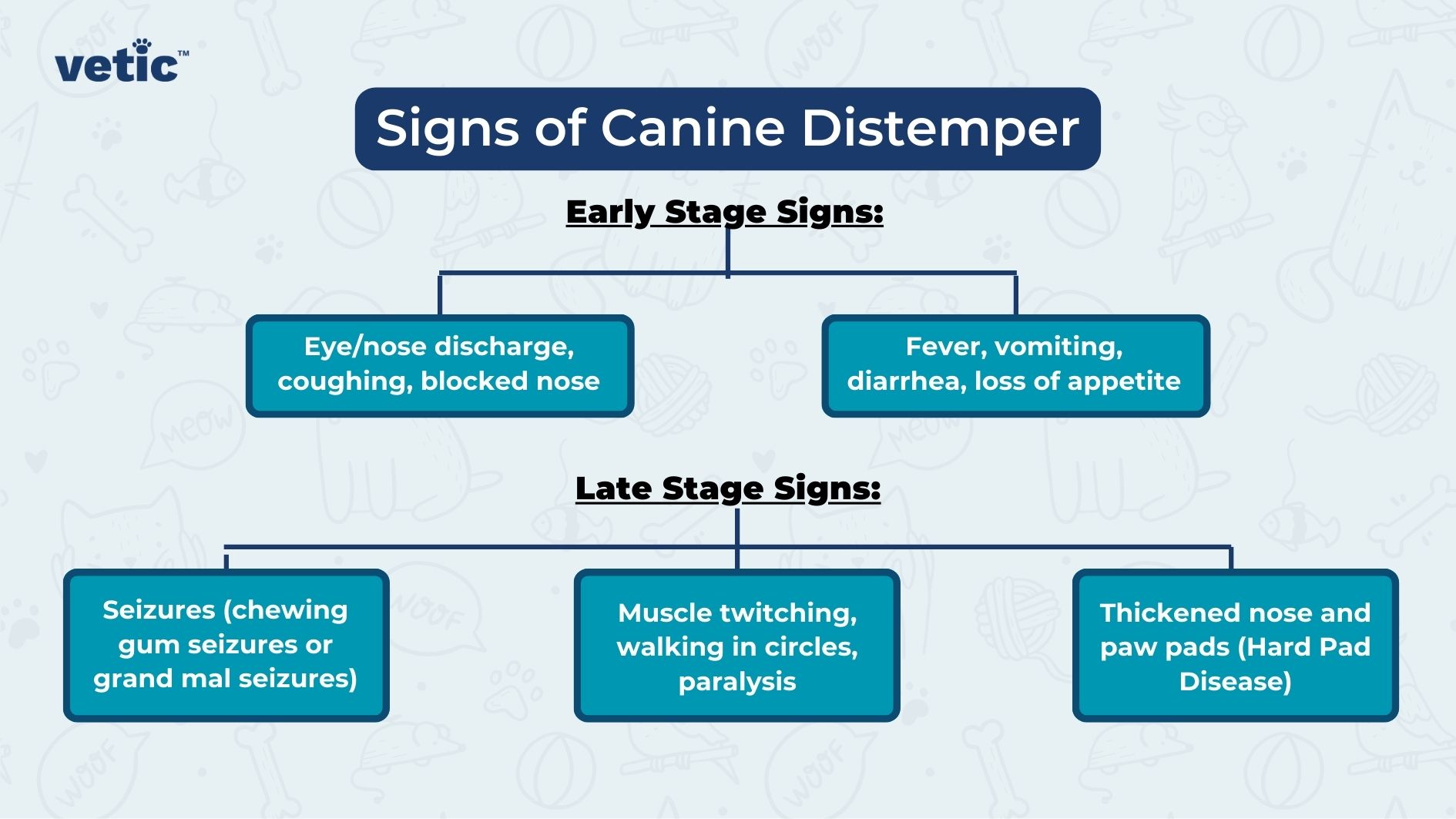
The signs of canine distemper can be divided into early stage and late stage. The signs of the early stage of canine distemper infection include –
- Discharge from the eyes and nose
- Coughing
- Blocked nose
- Fever
- Reduced appetite
- Vomiting
- Diarrhoea
The late stage signs of canine distemper infection include –
- Loss of coordination
- Chewing gum seizures
- Head tilting
- Grand mal seizures
- Twitching of muscles
- Walking in circles
- Partial or complete paralysis
- Thickening of the nose and footpads
Not all of these signs appear in infected dogs at the same time. If you notice more than one of these signs in your dog, you must speak with your veterinarian.
Why is Canine Distemper called the Hard Pad Disease?
Canine distemper infection in dogs causes their nose and footpads to thicken, also known as hyperkeratosis. It makes these areas incredibly sensitive and painful.
That has led doctors and researchers to call canine distemper the hard pad disease.
What are the Different Stages of Canine Distemper?
Stage One: Early Infection
- Watery to pus-like eye discharge (ocular discharge)
- Fever (appears 3-6 days after infection)
- Loss of appetite
- Clear nasal discharge
- Lethargy
- Coughing
- Vomiting and diarrhoea
- Rare: Pustular dermatitis
- Inflammation of the brain and spinal cord
Complications:
- Hyperkeratosis of paw pads and nose (commonly called “hard pad disease”)
- Secondary bacterial infections, causing:
- Respiratory issues (difficulty breathing, pneumonia)
- GI symptoms (vomiting, diarrhoea)
Stage Two: Neurological Effects
- Head tilt
- Circling behaviour
- Partial or full paralysis
- Seizures
- Nystagmus (rapid eye movements)
- Muscle twitching
- Convulsions (often with excessive salivation and chewing motions)
Unfortunately, many cases of canine distemper are fatal, and survivors may suffer from permanent nervous system damage.
How is Canine Distemper Diagnosed?
Canine distemper virus may be detected by antigen testing. Most veterinary hospitals have a distemper testing kit for dogs, which is a quick way to determine if a dog is positive for CDV.
However, a more sensitive and accurate diagnosis is done by running a rtPCR (real-time PCR) test on blood or whole serum sample, urine sample or even collected eye and nasal discharge.
Speak to your veterinary care provider to learn about the most efficient and sensitive test, which can accurately determine whether a dog has distemper or not.
What’s the Treatment for Canine Distemper?
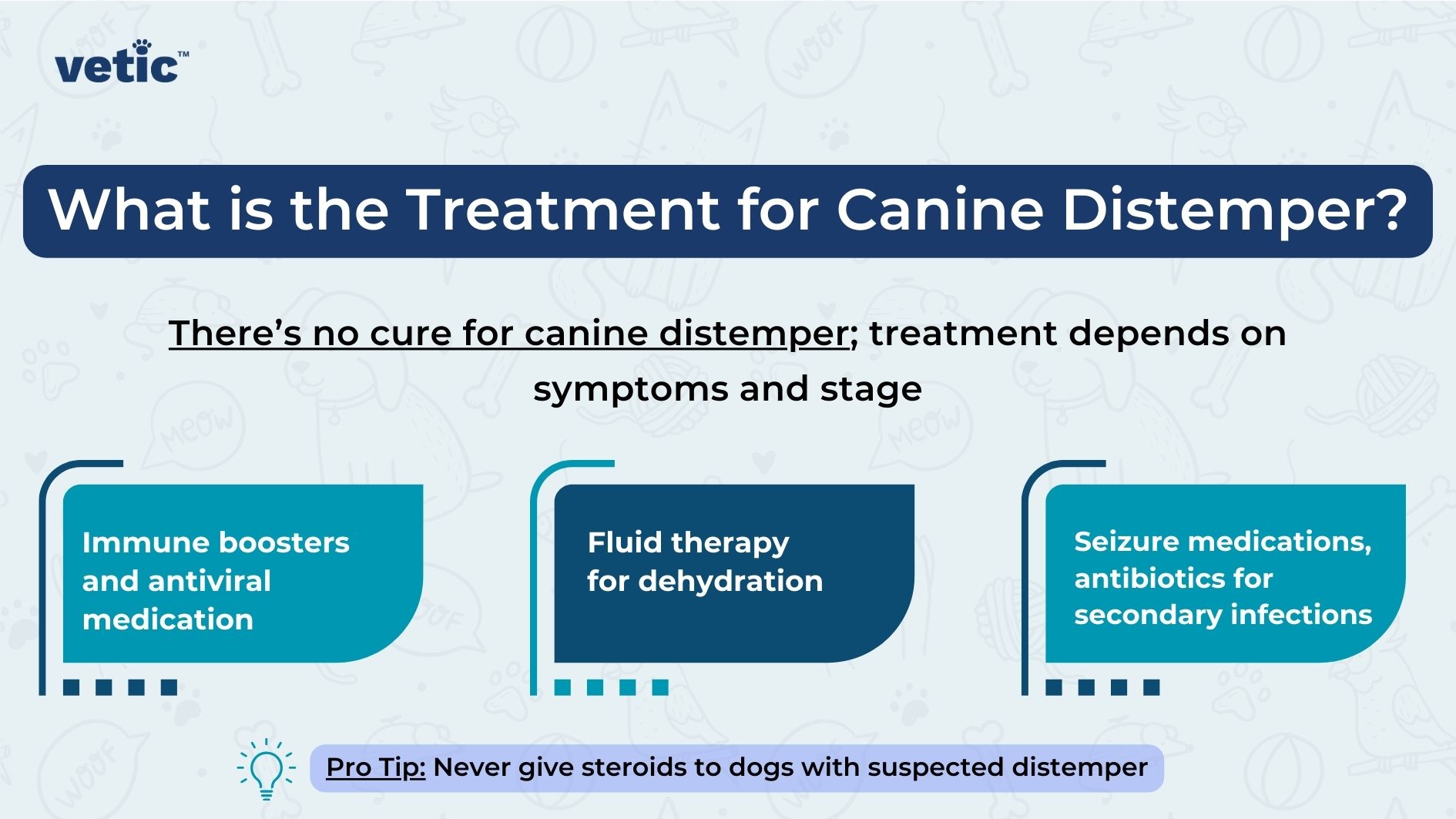
Just like most viral diseases, canine distemper in dogs does not have a standard treatment or cure. The treatment depends upon the signs of distemper, its stage and type.
However, in many cases, immunity boosters are recommended since the distemper virus cripples the immune system of the infected dog. These boosters usually include granulocyte-stimulating factors that can stimulate the bone marrow to produce White Blood Cells (WBCs) and release them into the bloodstream to fight the infection.
Many times, veterinarians may recommend the use of antiviral medication and canine distemper antibodies to reduce the viral load. However, not all human antiviral medicines can be used in dogs. So, do not try to medicate your dog without consulting an experienced veterinarian.
Other treatment include –
- Fluid therapy to make up for the dehydration
- Anti-inflammatory and antipyretic for the pain and internal swelling
- Anti-nausea medicines
- Medicine for seizures
- Vitamins for restoring nerve health and function
- Antibiotics for diarrhoea
- Antibiotics for congestion (pneumonia or URI)
- Supplements for liver, gut and kidney health
Pro Tip: Never give your dog steroids, such as dexamethasone or prednisolone, if they show signs of canine distemper. Steroids are powerful anti-inflammatory medications. However, steroids also suppress a dog’s immune system, which makes them more vulnerable to the pathogenicity of the canine distemper virus. Steroids should never be used in suspected canine distemper virus or confirmed CDV cases.
Can Canine Distemper be Cured?
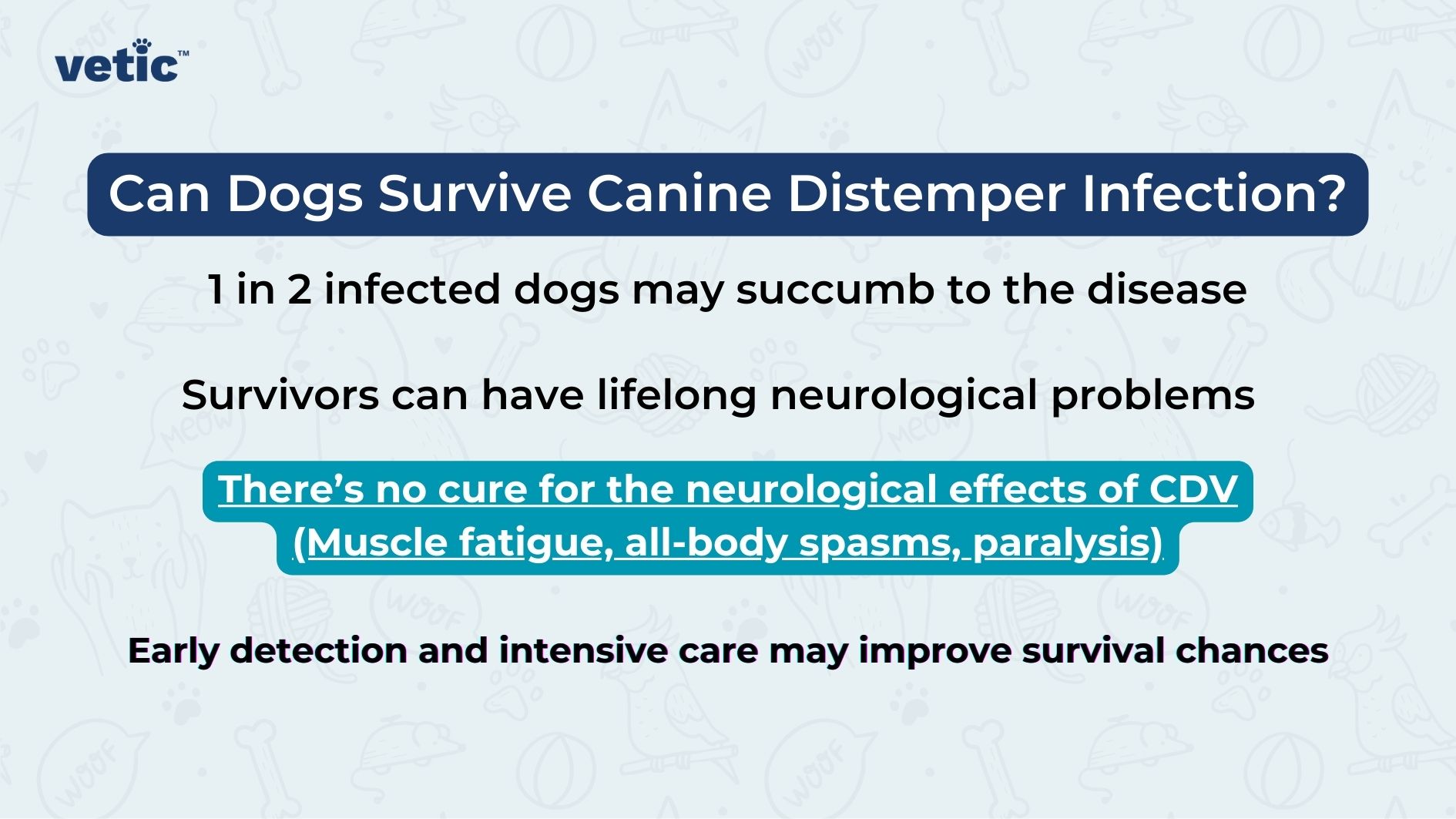
1 out of 2 dogs affected by canine distemper virus succumb to the disease. When the disease is diagnosed in its early stages (before the neural symptoms become prominent), intensive treatment can save a dog’s life.
However, recovered dogs continue to shed distemper virus in their stool, urine and other bodily secretions months after the infection. Most dogs who so survive CDV have life-long neurological deficits. They show signs such as chewing gum seizures, all-body tremors, muscle spasms, and localised twitching. Many dogs lose the ability to walk after a serious CDV infection.
Sadly, there is cure for these lifelong effects of distemper in dogs. These twitches, tics, spasms and seizures cause constant muscle fatigue and stress, and reduce the quality of life of the recovered dogs.
Is There a Vaccine for Canine Distemper?
The 9-in-1 vaccine, also known as the DHPPiL vaccine is administered to dogs for protection against canine distemper. Puppies require multiple doses within the first 120 days of their life, since their bodies quickly remove the antibodies after administration.
To be exact, a new puppy will require 1 dose of Puppy DP and 3 doses of DHPPiL within the first 105 days of their life.
Adult dogs require yearly 9-in-1 or DHPPiL vaccines to “remind” their immune system to produce antibodies against the distemper virus. If your dog has missed a vaccine dose, contact your veterinarian ASAP for vaccination.
Can You Protect Your Dog Against Canine Distemper?
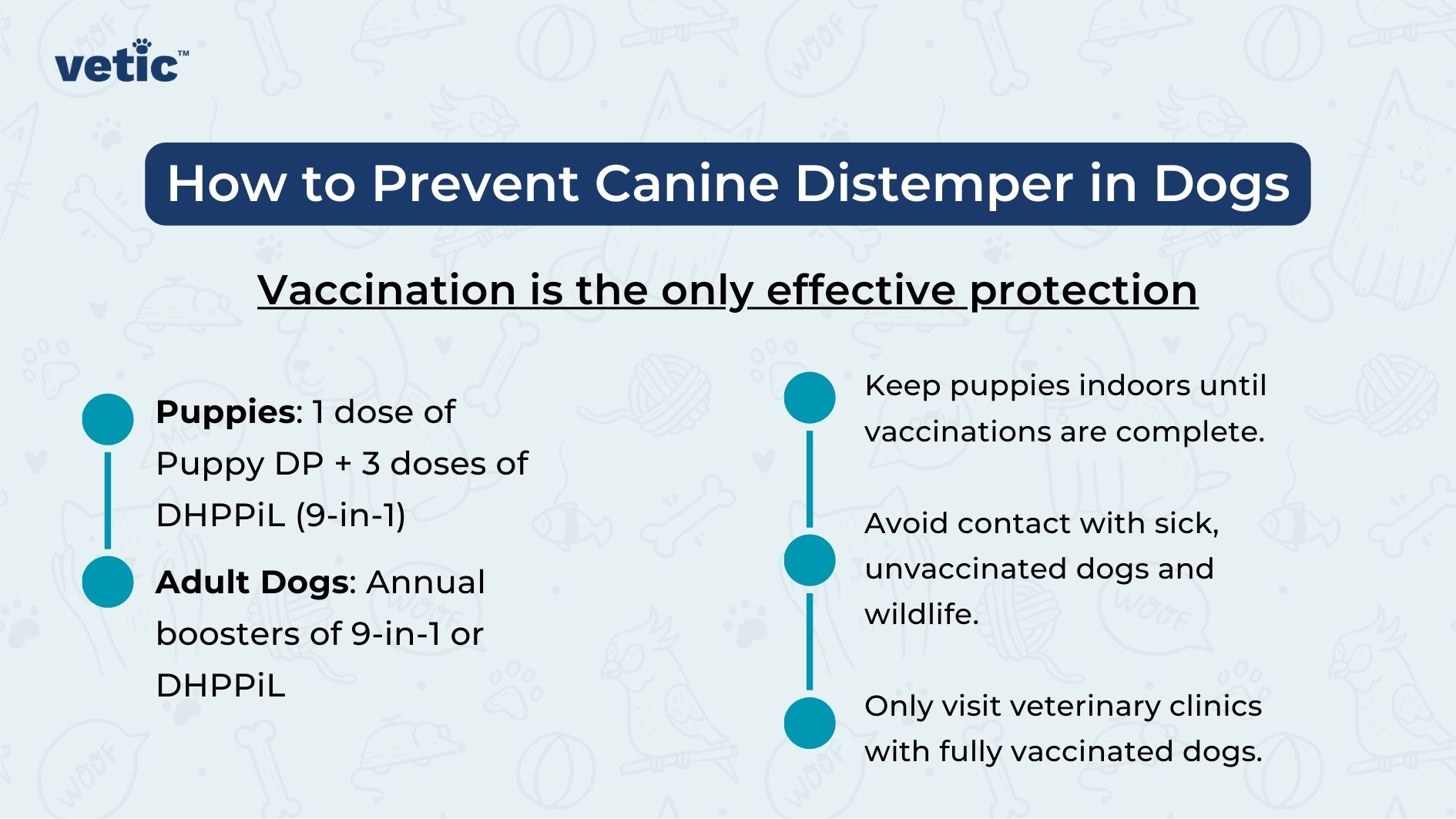
The only way to reduce your pup or dog’s risk of catching the CD virus is by vaccinating them on-time.
However, a few additional precautions will ensure your dog remains protected from canine distemper. It is possible to reduce the risk of canine distemper by following these steps –
- Do not take your puppy out before their vaccinations are complete, this includes pet shops, parks, dog creche and boardings, and groomers.
- Only go to veterinary clinics which host fully vaccinated dogs.
- Keep your dog away from sick or sick-looking dogs.
- Avoid contact with any unvaccinated dog and other wildlife.
Can Vaccinated Dogs Get Canine Distemper Virus?
Yes. vaccinated dogs can get canine distemper although the risks are considerably low. The vaccines offer immunity against multiple strains of the distemper virus. However, new strains evolve as the virus keeps mutating.
Some novel strains of CDV may escape the immune system and cause infection in vaccinated puppies and dogs as well. Hence, it’s important to talk to your veterinary care provider if your dog suddenly develops a fever, lethargy, nasal and eye discharge, diarrhoea, inappetence and difficulty in movements.
FAQs About Canine Distemper
Can Canine Distemper Spread to Other Animals?
Yes, CDV can affect animals like foxes, wolves, and lions, but domestic dogs are most susceptible.
Is Canine Distemper Fatal in Dogs?
Yes, canine distemper often proves fatal, especially if not caught early, as it severely weakens the immune system.
How Can I Recognize Canine Distemper Symptoms?
Look for fever, coughing, nasal discharge, vomiting, and neurological signs like seizures and muscle twitching in advanced cases.
How Do Dogs Catch Canine Distemper?
Dogs catch distemper mainly through direct contact with infected dogs’ saliva or mucus or by inhaling virus particles.
Is There a Cure for Canine Distemper?
No, there’s no cure; treatment focuses on supportive care, but early intervention improves survival chances.
Can a Vaccinated Dog Still Get Distemper?
Yes, though rare, vaccinated dogs can catch it if exposed to novel strains; regular check-ups are crucial.
What Does ‘Hard Pad Disease’ Mean?
‘Hard Pad Disease’ refers to distemper’s symptom of thickened, hardened nose and footpads, causing pain and sensitivity.
